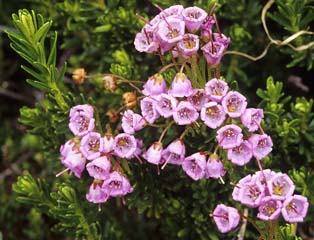 |
Pink mountain heather, Phyllodoce
empetriformis (Sm.) D. Don.
(left). Both this and the mountain heather shown on the
right are low evergreen plants. This one’s flowers are pink and its
joined petals roll outward along their margins. Phyllodoce was a water
nymph in Greek mythology. Why the names of mythological Greek characters
were applied to alpine heathers is a mystery; empetriformis, from
the Greek, means “on rocks.” Frederick Pursh in his 1813 Flora
reported seeing a Lewis and Clark specimen that was probably gathered in
north-central Idaho.
Merten’s mountain heather, Cassiope
mertensiana (Bong.) G. Don var. gracilis (Piper)
C. L. Hitchc. (right). Merten's mountain heather and the
pink mountain heather shown on the left are so closely related that they
often hybridize when growing close to each other. The plants are the same
size and have the same growth preferences. The name Cassiope is from
Greek mythology, the name of Andromeda’s mother. The species name honors
German botanist Franz Karl Merten. |
 |
 |
Alpine laurel, Kalmia
microphylla (Hook.)
A. Heller (left). Our alpine laurel is a ground hugging
plant closely related the Pennsylvania state flower, Kalmia
latifolia, a white-flowered shrub or small tree often used in ornamental
landscaping. The relationship between the two plants is confirmed by this
plant’s woody stem and almost identically shaped flowers. Often found
in the company of the two mountain heathers shown above, the alpine laurel
prefers wet mountain meadows and bogs, where it blooms soon after snowmelt.
Alpine laurel is poisonous to cattle and sheep—not usually a problem,
given the altitude at which it grows.
Rusty menziesia, Menziesia
ferruginea Sm. (right). Rusty
menziesia (also “false azalea” and “fool’s
huckleberry”) honors Archibald Menzies who first collected the plant.
It is an attractive deciduous shrub that grows from California to Alaska,
and inland to the northern Rocky Mountains. The plant prefers moist surroundings,
and is often found in the company of trapper’s tea. Urn-shaped flowers,
ranging in color from rust to bright red, help to identify it. The fruit
is inedible, hence the common name “fool’s huckleberry.”
Menziesias are sometimes used as ornamental shrubs in moist situations. |
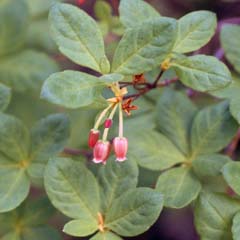 |
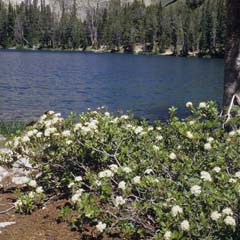 |
Trapper’s tea, Rhododendron
neoglandulosum Harmaja (left, right).
Trapper’s tea (formerly Ledum glandulosum or L.
groenlandica) is a leathery leaved, western subapine to alpine
plant that blooms in early summer. Its large white flowerheads, set off by
deep green leaves, are striking. The fruit is a small brownish capsule that
contains numerous seeds. The derivation of the name, “trapper's tea”
is uncertain; presumably the leaves were used as a beverage in the distant
past. Readers should not emulate our pioneer forebears, because the plant
is poisonous. |
 |
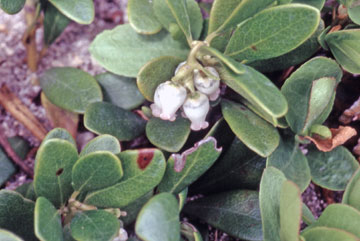 |
Kinnikinnick, Arctostaphylos
uva-ursi (L.) Spreng (left, right). Kinnikinnick is
a circumboreal plant found throughout the northern United States and Canada
as well as in Europe and Asia. It is a ground-hugging plant with oval leathery
leaves, urn-shaped early-blooming white flowersthat mature into bright red
berries. The fruit is not really palatable, but Native Americans used it
as a component of pemmican. A fur trader gave Lewis and Clark a specimen
of kinnikinnick while they were overwintering at the Mandan Villages in
today’s North Dakota (1804-1805). He told them that the Indians mixed
leaves of kinnikinnick with the bark of the red-osier dogwood and with tobacco
to stretch the tobacco supply. Kinnikinnick grows in our mountains, in moist
or shady locations, and on alpine tundra. |
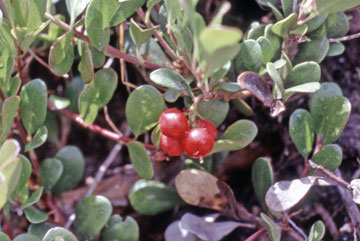 |
 |
Grouseberry, Vaccinium
scoparium Leiberg ex Coville
(right and left). The grouseberry (also grouse
whortleberry) is a small mountain plant that often forms dense patches of
ground cover at high elevations. The plants have many thin branches and if
bundled form a serviceable broom (scoparium means broom-like). In
good years the plants bear many small flowers typical of those of other
Vaccinium species (blueberries, cranberries, etc.). These ripen into
red berries that taste like sweet blueberries. Other vacciniums grow in our
mountains, but the grouseberry is the most common species at higher
elevations. |
 |









